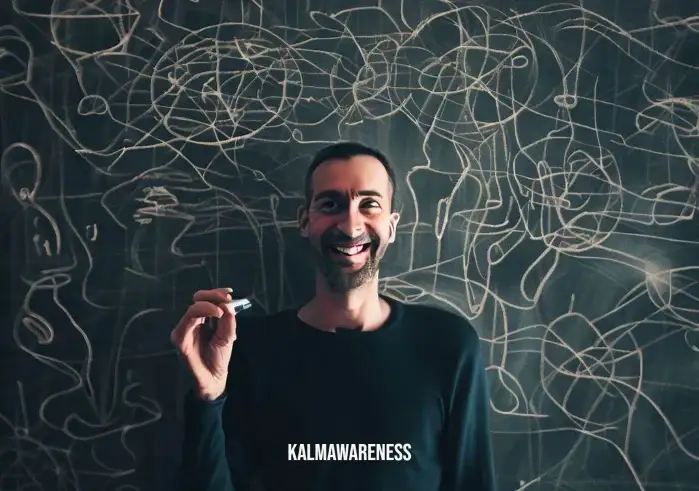Journey to Calm Thoughts: The Pathway to Inner Peace and Well-being
Understanding Calm Thoughts and Their Importance
Calm thoughts play a quintessential role in our mental well-being. Living in a fast-paced world, many of us forget the essence of serenity and mindfulness. The journey to such thoughts isn’t a destination but a continuous process. Let’s embark on this enlightening journey together.
The Anatomy of Calm Thoughts
When you think about calm thoughts, what comes to mind? Perhaps it’s the idea of attaining a peaceful state of mind where worries don’t occupy our thoughts. These moments are sacred. They’re the intervals of tranquillity in the cacophonous symphony of life.
It’s a universal truth: everyone seeks calmness. We buy mindfulness toys, look for mindful backgrounds to set on our phones, and even attend sessions that guide us towards achieving a mindful state.
“Calm thoughts are the antidote to life’s chaos.”
Why Are Calm Thoughts Essential?
Our minds are perennially active, processing thousands of thoughts every minute. A majority of these thoughts revolve around our past or the uncertain future, leading to anxiety and stress. This is where the importance of calmfulness comes in.
- Mental Well-being: The more we nurture calm thoughts, the better our mental health. It’s a form of detox for your heart and mind, ensuring you remain positive.
- Physical Health: Calm thoughts indirectly influence our physical health. With reduced stress and anxiety levels, our body functions optimally. The physical and mental benefits of meditation is a testament to this.
- Improved Relationships: A calm mind leads to positive interactions. When we approach situations with serenity, conflicts reduce, and understanding improves.
- Enhanced Productivity: When the mind isn’t burdened by unnecessary worries, it becomes a fertile ground for creativity and efficiency.
Beginning the Journey
Starting the journey towards calm thoughts can be daunting. But every profound journey begins with a single step or, in our case, a moment to pause. Whether it’s through a 10-minute silent meditation or engaging in walking meditation, the pathways are endless.
A common misconception is that calmness implies the absence of emotions. In reality, it means being aware of them without being overwhelmed. Exploring the space for anxiety can sometimes be the first step in understanding one’s emotional terrain.
Lastly, remember, everyone’s journey is unique. What works for one might not work for another. It’s crucial to find what resonates with you. Whether it’s listening to binaural beats to alleviate stress or understanding the waves of anxiety that plague our brain, the path you choose is yours alone.
Thank you for accompanying me in the first part of our journey. I invite you to continue to the next segment where we delve deeper into the practices and tools that aid in nurturing calm thoughts and achieving inner peace. We’ll discuss the role of gratitude, meditation, and self-compassion, and how they intertwine to guide us towards a serene state of being.

Embracing Gratitude and the Power of Reframing
The Magic of Gratitude
“Gratitude” is more than just a buzzword in the world of mindfulness and mental well-being. It is a powerful emotion that can bring transformative effects to our lives. When we approach life with gratitude, we focus on the positives, making it easier to foster calm thoughts.
- Embracing Gratefulness: To lead a life where we wake up with gratitude is to open ourselves to the myriad of blessings life offers us each day.
- Gratitude and Perception: It’s interesting to note that gratitude doesn’t change our circumstances but shifts our perspective. As the saying goes, “gratitude helps you see what’s there instead of what isn’t“.
- Inculcating Daily Habits: One way to imbibe gratitude is by ending each day on a note of thankfulness. Reflecting on things to be grateful for each day can be a powerful exercise in positive thinking.
Name It, Tame It, Reframe It: The Power of Thought Regulation
“Name it, tame it, reframe it” isn’t just a catchy phrase. It’s a formula that serves as a guiding principle in the world of emotional intelligence and self-regulation.
- Name It: The first step towards regulating any emotion or thought is to recognize and name it. Are you feeling anxious? Angry? Or overwhelmed? Acknowledging these feelings can be akin to lighting a lamp in a dark room.
- Tame It: Once you’ve identified the emotion, the next step is to manage or “tame” it. This could be through methods like meditation, understanding the brain wave entrainment process, or simply taking a moment to breathe and ease your mind.
- Reframe It: This is where the power of perspective comes into play. Reframing involves looking at a situation or emotion from a different viewpoint. Instead of seeing a problem as insurmountable, can we view it as a challenge? By altering our perception, we pave the way for solutions and peace of mind.
Techniques to Foster Calm Thoughts
| Technique | Description | Related Article |
|---|---|---|
| Guided Meditation | Using a guide (either a person or recording) to lead you through a meditation. | Blissful Guided Meditation |
| Binaural Beats | Auditory illusion to relax the mind by listening to two different frequencies in each ear. | Binaural Beats for Stress |
| Inner Child Healing | Reconnecting and nurturing the child within to heal past traumas. | Inner Child Healing Quotes |
| Grounding Exercises | Techniques used to bring the individual back to the present moment, especially useful during episodes of anxiety. | Grounding into Gratitude |
| Tapping (Emotional Freedom Techniques) | A combination of ancient Chinese acupressure and modern psychology to relieve emotional distress. | Tapping for Forgiveness |
Thank you for delving deeper into the journey of calm thoughts with me. As we venture forward, we’ll uncover more techniques, the importance of self-compassion, and how we can align our daily activities to foster inner peace. Stay tuned for an enlightening exploration in the next segment.

The Role of Compassion and Self-talk in Calm Thoughts
Self-compassion: The Heart of Inner Peace
“Talk to yourself like you would to someone you love.” – Brené Brown
Self-compassion plays a pivotal role in nurturing our mental well-being. When we speak about the principle of “name it, tame it, reframe it,” it goes beyond just identification and management of emotions. It involves treating oneself with kindness, understanding, and love.
Brené Brown, a renowned researcher, emphasizes the role of vulnerability and compassion in our lives. Her studies on mental health shed light on how we often neglect the importance of being kind to ourselves. It’s easier to forgive others than it is to forgive ourselves. But when we start to view our missteps and failures with self-compassion, we open the door to healing and tranquility.
The Power of Positive Self-talk
“The mind is everything. What you think you become.” – Buddha
Our minds hold immense power over our actions and feelings. Positive self-talk is the practice of responding to challenging situations with a positive statement or mantra. Instead of succumbing to a spiral of negative thoughts, we can harness the ability to lift ourselves using affirmations and positive words.
One effective technique to break free from negative patterns is to visualize certain situations or feelings as images. For instance, consider the concept of self-talk images. By associating our emotions with images, it becomes easier to “name it, tame it, and reframe it.”
“You yourself, as much as anybody in the entire universe, deserve your love and affection.” – Sharon Salzberg
By repeating positive affirmations and transforming the way we talk to ourselves, we create a nurturing environment for our minds. This approach is closely related to the idea of mindful transformation. When we imbibe positive self-talk as a part of our daily routine, it becomes a protective barrier against stress and negativity.
Harnessing the Wisdom of the Ages
Ancient wisdom has always emphasized the importance of inner peace, compassion, and positive thinking. These are not new-age concepts but time-tested strategies that have been championed by spiritual leaders and philosophers over millennia.
“Peace comes from within. Do not seek it without.” – Buddha
Embracing calm thoughts is akin to allowing a gentle stream to flow within us, clearing away the muddied waters of stress, anxiety, and doubt. Such an idea is beautifully encapsulated in the quote: “here comes a thought,” reminding us that thoughts, no matter how overwhelming, are transient. They come and go, and we have the power to choose which ones we dwell on.
“Between stimulus and response, there is a space. In that space is our power to choose our response. In our response lies our growth and our freedom.” – Viktor E. Frankl
Recognizing this “space” Frankl speaks of is the essence of “name it, tame it, reframe it.” By identifying the gap between our reactions and actions, we gain the power to influence our thoughts positively.
Embarking on the journey of self-awareness and inner peace is a continuous process. As we proceed to the next chapter, we’ll delve deeper into practical strategies, the role of grounding, and the transformative power of gratitude. Join me in unraveling the mysteries of the mind and achieving true tranquility.

Cultivating Hope and Resilience Through Calm Thoughts
Planting Seeds of Hope
“Hope is the thing with feathers that perches in the soul – and sings the tunes without the words – and never stops at all.” – Emily Dickinson
Throughout history, hope has been the beacon that guided individuals through the darkest nights. It’s the essence of calm thoughts, providing solace in moments of despair. The process of “name it, tame it, reframe it” becomes significantly more powerful when intertwined with the notion of hope. To truly tame our thoughts, we must infuse them with a sense of future and optimism, believing in better tomorrows.
Andrew Huberman, a neuroscientist, speaks extensively about the influence of gratitude on hope. His studies show that gratitude not only brings immediate satisfaction but plants the seeds of future hope. By focusing on the gifts of today, we lay the foundation for hopeful tomorrows.
Embracing Resilience with Calm Thoughts
“Our greatest glory is not in never falling, but in rising every time we fall.” – Confucius
Resilience is the ability to bounce back from setbacks. It’s the mental fortitude that allows us to forge ahead, despite challenges. But how do we cultivate this trait? The answer lies in maintaining calm thoughts, practicing self-compassion, and regularly reminding ourselves to “name it, tame it, reframe it.”
The practice of grounding into gratitude can be an invaluable tool for building resilience. It provides perspective, reminding us of our past triumphs and the strength we’ve mustered in challenging times.
Empowering Through Knowledge
To further understand the relation between calm thoughts, hope, and resilience, let’s look at a table showcasing some strategies, their immediate benefits, and long-term impacts.
| Strategy | Immediate Benefit | Long-term Impact |
|---|---|---|
| Mindful Breathing | Calms the nervous system | Promotes emotional stability |
| 10-minute Zen Meditation | Reduces stress levels | Enhances focus and clarity |
| Walking Meditation | Grounds the individual | Fosters a deeper connection with nature |
| Coloring Mindfully | Offers a break from overthinking | Boosts creativity |
| Listening to Binaural Beats | Eases anxiety | Improves sleep quality |
Through this table, it’s evident that simple daily practices can significantly bolster our mental well-being, both in the present and future.
“In the middle of every difficulty lies opportunity.” – Albert Einstein
Every challenge, every setback, and every moment of doubt carries within it the seeds of growth and opportunity. By following practices that foster calm thoughts and applying the principle of “name it, tame it, reframe it,” we not only navigate challenges but grow stronger through them.
As we transition to the next segment of this exploration, we will delve deeper into the universe of mindfulness. From its origins to its modern-day applications, join us in unraveling the intricate tapestry of mindfulness, calm thoughts, and mental well-being.

The Art and Craft of Embracing Calm Thoughts
The Symphony of Emotions
Just as an orchestra blends a multitude of instruments to create harmonious music, our minds are home to a medley of thoughts and emotions. Occasionally, cacophony may ensue, but with the right conductor – our awareness – we can create a serene symphony. This awareness is where the principle of “name it, tame it, reframe it” plays a pivotal role.
Imagine walking through an art gallery where every painting is a reflection of a thought or emotion. Some paintings might be vibrant, some dark, while others might be abstract. As we navigate through this gallery of our mind, the mantra “name it, tame it, reframe it” becomes the lens that allows us to appreciate every artwork, regardless of its nature.
The Tapestry of Mindfulness and Calm Thoughts
The canvas of mindfulness is vast and varied. From meditation practices rooted in ancient traditions to modern-day mindfulness toys that offer grounding experiences, this realm has something for everyone.
For instance, the Mindfulness Toy isn’t just a plaything; it’s a tangible tool that aids in grounding and centering the individual, acting as a bridge between the tangible and intangible realms of our experience. Similarly, immersing oneself in a Mindful Background during meditation can act as a gateway, guiding the practitioner into deeper realms of tranquility.
Metaphors and Calm Thoughts
Think of our mind as a vast ocean. At times, it’s calm, reflecting the blue skies, while at other moments, it’s turbulent with crashing waves. Calm thoughts are the gentle lullabies that soothe this vast ocean, turning tempestuous waves into serene ripples. By practicing Meditation Float, one can experience this sense of floating amidst the vast ocean of our consciousness, safe and supported.
Anecdotes to Illuminate the Journey
I recall a poignant story of a monk who was perennially serene. One day, a disciple asked him the secret behind his eternal calm. The monk, with a gentle smile, pointed towards a fluttering Breathing Ball Toy in the corner. “That ball,” he began, “reminds me to breathe, to stay present. Every time I find myself lost in the maze of thoughts, I simply turn to it, synchronize my breath, and find my way back.”
This story beautifully encapsulates the essence of “name it, tame it, reframe it.” By naming the emotion, the monk recognized his drift; by synchronizing with the breathing ball, he tamed it; and by returning to the present moment, he reframed his perspective.
Immersive Poetry: A Dive into Calm Thoughts
In the realm of silence, whispers emerge, Echoing the tales of a heart’s gentle surge. Amidst the clamor, a voice so profound, Guiding us to where calm thoughts are found.
Dive deep into the Space for Anxiety, let not worries bind, For in the depths of consciousness, serenity you’ll find. “Name it, tame it, reframe it,” the winds chime, A mantra for ages, transcending time.
As we wrap up this segment, let’s remember that the journey to achieving calm thoughts is as varied as the myriad colors of a sunset. It’s a blend of art and science, tradition and innovation, and above all, self-awareness and compassion.
As we transition to the next chapter, join us on a deeper exploration into the tools and techniques that have been crafted over centuries, all aimed at helping us cultivate a calm, serene, and harmonious mind.

Coming Full Circle – The Gentle Ebb and Flow of Calmness
The Gentle Ripple Effect
“Water does not resist. Water flows.” – Margaret Atwood
The human mind, much like water, is beautifully fluid, adaptable, and constantly in motion. However, amidst the bustling flow of daily life and its multiple challenges, it can easily lose its natural rhythm. But, with the right guidance, tools, and a pinch of awareness, we can steer our minds back to their inherent tranquility. The strategy of “name it, tame it, reframe it” is akin to finding the river’s course amidst an uncharted forest. The key is to let the current take its course, not by resisting, but by gently directing it.
The Lighthouse of Calm Thoughts
Consider for a moment the role of a lighthouse. Amidst a vast sea of turbulent waves and uncertain horizons, it stands tall, casting a beacon of hope and direction for lost sailors. Our practices, our mindfulness tools, and techniques, act as such guiding lights. For readers who’ve found solace in our previous chapters and wish to delve deeper, our Mindful Monthly Magazine is brimming with insights, stories, and resources tailored just for you.
Embracing the Natural Cycle
Every ending is a new beginning. Just as the seasons change, bringing with them fresh aromas, colors, and experiences, so does our journey of self-awareness. The strategy to “name, tame, and reframe” isn’t a one-off practice; it’s a lifestyle. It’s about recognizing the cyclical nature of our emotions, much like the ebb and flow of the tide. And with every cycle, there’s a new opportunity to understand, grow, and evolve.
Farewell, Yet Not Goodbye
“It is not the end, nor is it the beginning. It is the infinite middle.” – Stacey Abrams
Our journey through the art of calm thoughts, of understanding emotions, and of embracing the “name it, tame it, reframe it” mantra has been enlightening. We part ways in this series, but the doors to knowledge and wisdom remain ajar. For those seeking a deeper dive and a more consistent touchpoint, our Weekly Wisdom Digest offers an enriching experience. Every edition is a blend of the old and the new, designed to offer solace, guidance, and a touch of the serene.
To New Beginnings and Timeless Wisdom
In parting, a quote by T.S. Eliot comes to mind, “We shall not cease from exploration, and the end of all our exploring will be to arrive where we started and know the place for the first time.”
With that sentiment, dear readers, we encourage you to continuously embark on this voyage of self-awareness, armed with the mantra to “name it, tame it, reframe it.” And as you tread this path, remember that we, at KalmAwareness, are always here to guide, inspire, and walk alongside you.
Here’s to calm minds, gentle hearts, and a world full of mindfulness. Until our paths cross again, journey well and stay serene.




